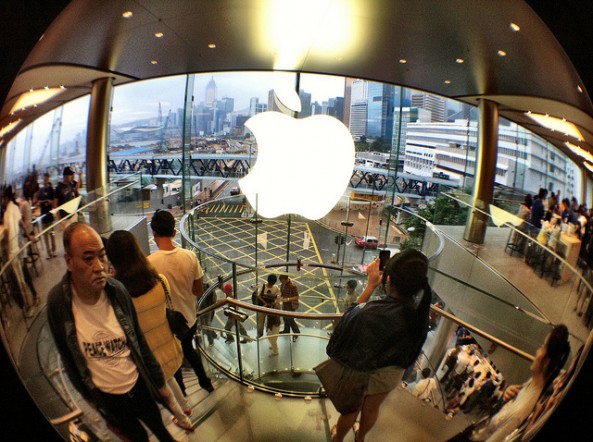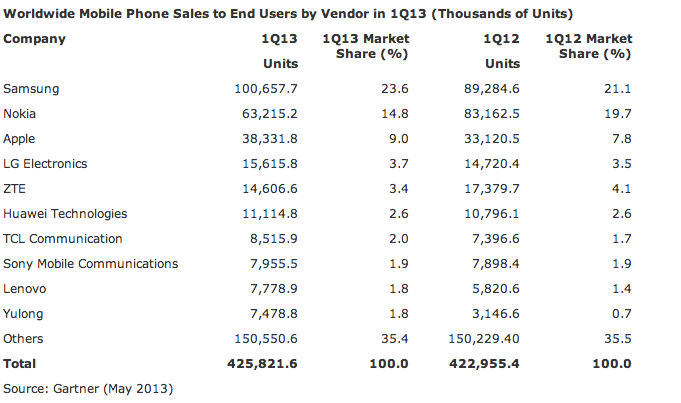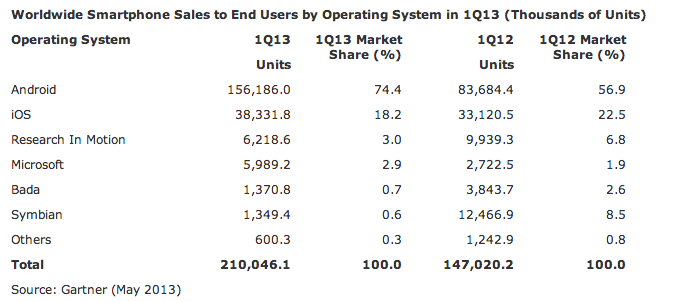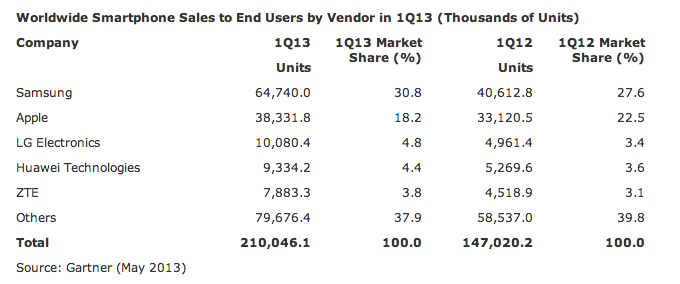When seeking increased sales of mobile phones, observers need to look east. That’s the word from one large analyst firm, noting more than half of all mobile phones sold during the first quarter of 2013 were in the Asia/Pacific market. For Apple, its sales in mainland China alone neared seven million units during the period, largely credited to the lower-priced iPhone 4. Worldwide, the California-based smartphone maker saw its share of mobile phone sales rise…
Principal Gartner researcher Anshul Gupta noted that more than 226 million mobile phones were sold to end users in Asia/Pacific in the first quarter of 2013, “which helped the region increase its share of global mobile phones to 53.1 percent year-on-year.”
China’s portion of that: a whopping 25.7 percent.
By comparison, North American mobile phone sales for the first quarter dropped 9.5 percent, with Japanese sales off 7.3 percent and Latin American mobile phone demand slipping 3.8 percent.
According to Gartner, Apple is No. 3 in worldwide mobile phone sales, selling 38.3 million units during the first quarter. That translates to a nine percent share of the overall handset market, up from 7.8 percent for the first quarter of 2012. the iPhone maker’s showing is impressive given that unlike other handset makers, Apple sells only high-end smartphones.
Apple’s chief rival, South Korea’s Samsung is the No. 1 mobile phone player, selling just over a hundred million units for a nice 23.6 percent of the market in the first quarter. The small percentage of growth for both companies – just over one percent for Apple and almost two percent for Samsung – underscores the tight competition.
“China is a key contributor to overall sales for Apple,” the research firm announced. “Apple is faced with the challenge of being increasingly dependent in the replacement market as its addressable market is capped,” claims the analyst.
Making that challenge even more formidable is the expectation Apple won’t announce a new product before the third quarter of 2013.
In terms of the competition between Apple’s iOS and Google’s Android, the software powering most of Apple’s rivals now controls nearly 75 percent of smartphones sold.
Android had 74.4 percent of the smartphone market in the first quarter, a dramatic rise from 56.9 percent during the first quarter of 2012. More than 156 million Android-based smartphones sold during the first quarter.
By comparison, Apple’s share of smartphone sales fell to 18.2 percent, down from 22.5 percent in the same quarter of 2012. Microsoft was the only non-iOS or non-Android smartphone to register a quarterly increase in sales.
The company marked 2.9 percent of the smartphone market during the first quarter, up from 1.9 percent in 2012. Only one-tenth of one percent separated No. 3 BlackBerry and No. 4 Microsoft, according to the research firm.
Although smartphones now outnumber feature phones, more feature phone owners are staying put, either considering the handsets good enough or waiting until smartphone prices drop, the researcher announced. “Either way the prospect is certainly not good for for both vendors and carriers looking to move users forward,” said Gupta.
According to the research firm, smartphones comprised 49.3 percent of all mobile phones sold during the first quarter. That’s up 44 percent from the fourth quarter of 2012 and 34.8 percent from a year ago. By contrast, feature phone sales dropped by 21.8 percent during the first quarter of 2013.
Samsung and other Android devices were the major beneficiaries of the move to smartphones. The South Korean firm’s lead expanded during the first quarter, growing to 30.8 percent of smartphone sales, up from 27.6 percent a year ago.
Meanwhile, Apple’s share of smartphone sales contracted, dropping to 18.2 percent of global sales, down from 22.5 percent in the first quarter of 2012. Despite the market slippage, Apple maintains its No. 2 position in smartphone sales.



